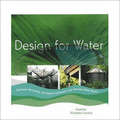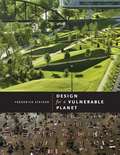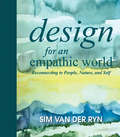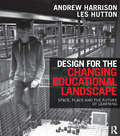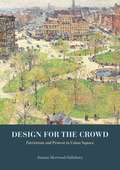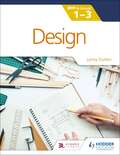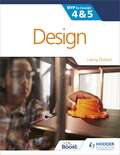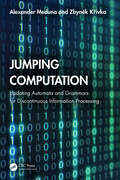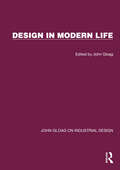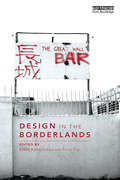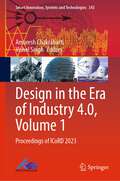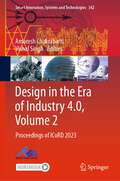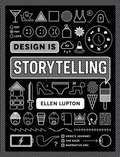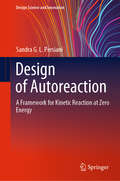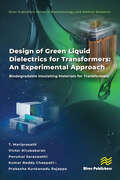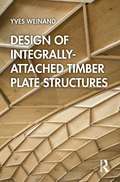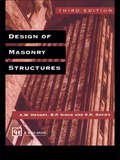- Table View
- List View
Design for Water: Rainwater Harvesting, Stormwater Catchment, and Alternate Water Reuse
by Heather Kinkade-LevarioIn an era of dwindling resources, water is poised to become the new oil. The entire world now faces the reality of a decreasing supply of clean water. To avert a devastating shortage, we must not only look at alternate water sources for existing structures but must plan our new developments differently. Design for Water is an accessible and clearly written guide to alternate water collection, with a focus on rainwater harvesting in the urban environment. The book:* Outlines the process of water collection from multiple sources--landscape, residential, commercial, industrial, school, park, and municipal systems* Provides numerous case studies* Details the assembly and actual application of equipment* Includes specific details, schematics, and referencesAll aspects of rainwater harvesting are outlined, including passive and active system setup, storage, storm water reuse, distribution, purification, analysis, and filtration. There is even a section on rainwater harvesting for wildlife.In addition to rainwater, there are several affordable and accessible alternate sources, including cooling tower bleed-off water, air conditioning condensate, gray water, and fog collection. Design for Water is geared to providing those making development decisions and guidelines with the information they need to set up passive harvesting techniques. The book will especially appeal to engineers, landscape architects, municipal decision-makers, developers, and landowners. Heather Kinkade-Levario is a land-use planner in Arizona and the author of the award-winning Forgotten Rain. She is president of Forgotten Rain L.L.C., a rainwater harvesting and stormwater reuse company.
Design for a Better World: Meaningful, Sustainable, Humanity Centered
by Donald A. NormanHow human behavior brought our world to the brink, and how human behavior can save us.The world is a mess. Our dire predicament, from collapsing social structures to the climate crisis, has been millennia in the making and can be traced back to the erroneous belief that the earth&’s resources are infinite. The key to change, says Don Norman, is human behavior, covered in the book&’s three major themes: meaning, sustainability, and humanity-centeredness. Emphasize quality of life, not monetary rewards; restructure how we live to better protect the environment; and focus on all of humanity. Design for a Better World presents an eye-opening diagnosis of where we&’ve gone wrong and a clear prescription for making things better.Norman proposes a new way of thinking, one that recognizes our place in a complex global system where even simple behaviors affect the entire world. He identifies the economic metrics that contribute to the harmful effects of commerce and manufacturing and proposes a recalibration of what we consider important in life. His experience as both a scientist and business executive gives him the perspective to show how to make these changes while maintaining a thriving economy. Let the change begin with this book before it&’s too late
Design for a Sustainable Culture: Perspectives, Practices and Education (Routledge Studies in Culture and Sustainable Development)
by Astrid Skjerven Janne ReitanAs culture is becoming increasingly recognised as a crucial element of sustainable development, design competence has emerged as a useful tool in creating a meaningful life within a sustainable mental, cultural and physical environment. Design for a Sustainable Culture explores the relationship between sustainability, culture and the shaping of human surroundings by examining the significance and potential of design as a tool for the creation of sustainable development. Drawing on interdisciplinary case studies and investigations from Europe, North America and India, this book discusses theoretical, methodological and educational aspects of the role of design in relation to human well-being and provides a unique perspective on the interface between design, culture and sustainability. This book will appeal to researchers as well as postgraduate and undergraduate students in design and design literacy, crafts, architecture and environmental planning, but also scholars of sustainability from other disciplines who wish to understand the role and impact of design and culture in sustainable development.
Design for a Vulnerable Planet
by Frederick SteinerWe inhabit a vulnerable planet. The devastation caused by natural disasters such the southern Asian tsunami, Hurricanes Katrina and Ike, and the earthquakes in China's Sichuan province, Haiti, and Chile-as well as the ongoing depletion and degradation of the world's natural resources caused by a burgeoning human population-have made it clear that "business as usual" is no longer sustainable. We need to find ways to improve how we live on this planet while minimizing our impact on it. Design for a Vulnerable Planet sounds a call for designers and planners to go beyond traditional concepts of sustainability toward innovative new design that fosters regeneration and resilience. Drawing on his own and others' experiences across three continents, Frederick Steiner advocates design practice grounded in ecology and democracy and informed by critical regionalism and reflection. He begins by establishing the foundation for a more ecological approach to planning and design, adopting a broad view of ecology as encompassing human and natural, urban and wild environments. Steiner explores precedents for human ecological design provided by architect Paul Cret, landscape architect Ian McHarg, and developer George Mitchell while discussing their planning for the University of Texas campus, the Lake Austin watershed, and The Woodlands. Steiner then focuses on emerging Texas urbanism and extends his discussion to broader considerations beyond the Lone Star State, including regionalism, urbanism, and landscape in China and Italy. He also examines the lessons to be learned from human and natural disasters such as 9/11, Hurricane Katrina, and the BP oil spill. Finally, Steiner offers a blueprint for designing with nature to help heal the planet's vulnerabilities.
Design for an Empathic World: Reconnecting People, Nature, and Self
by Sim Ryn Francine AllenDespite an uncertain economy, the market for green building is exploding. The US green building market has expanded dramatically since 2008 and is projected to double in size by 2015 (from $42 billion in construction starts to $135 billion). But green-building pioneer Sim Van der Ryn says, "greening" our buildings is not enough. He advocates for "empathic design", in which a designer not only works in concert with nature, but with an understanding of and empathy for the end user and for ones self. It is not just one of these connections, but all three that are necessary to design for a future that is more humane, equitable, and resilient. Sim's lifelong focus has been in shifting the paradigm in architecture and design. Instead of thinking about design primarily in relation to the infrastructure we live in and with--everything from buildings to wireless routing--he advocates for a focus on the people who use and are affected by this infrastructure. Basic design must include a real understanding of human ecology or end-user preferences. Understanding ones motivations and spirituality, Sim believes, is critical to designing with empathy for natural and human communities. In Design for an Empathic World Van der Ryn shares his thoughts and experience about the design of our world today. With a focus on the strengths and weaknesses in our approach to the design of our communities, regions, and buildings he looks at promising trends and projects that demonstrate how we can help create a better world for others and ourselves. Architects, urban designers, and students of architecture will all enjoy this beautifully illustrated book drawing on a rich and revered career of a noted leader in their field. The journey described in Design for an Empathic World will help to inspire change and foster the collaboration and thoughtfulness necessary to achieve a more empathic future.
Design for the Changing Educational Landscape: Space, Place and the Future of Learning
by Andrew Harrison Les HuttonThe whole landscape of space use is undergoing a radical transformation. In the workplace a period of unprecedented change has created a mix of responses with one overriding outcome observable worldwide: the rise of distributed space. In the learning environment the social, political, economic and technological changes responsible for this shift have been further compounded by constantly developing theories of learning and teaching, and a wide acceptance of the importance of learning as the core of the community, resulting in the blending of all aspects of learning into one seamless experience. This book attempts to look at all the forces driving the provision and pedagogic performance of the many spaces, real and virtual, that now accommodate the experience of learning and provide pointers towards the creation and design of learning-centred communities. Part 1 looks at the entire learning universe as it now stands, tracks the way in which its constituent parts came to occupy their role, assesses how they have responded to a complex of drivers and gauges their success in dealing with renewed pressures to perform. It shows that what is required is innovation within the spaces and integration between them. Part 2 finds many examples of innovation in evidence across the world – in schools, the higher and further education campus and in business and cultural spaces – but an almost total absence of integration. Part 3 offers a model that redefines the learning landscape in terms of learning outcomes, mapping spatial requirements and activities into a detailed mechanism that will achieve the best outcome at the most appropriate scale. By encouraging stakeholders to creating an events-based rather than space-based identity, the book hopes to point the way to a fully-integrated learning landscape: a learning community.
Design for the Crowd: Patriotism and Protest in Union Square
by Joanna Merwood-SalisburySituated on Broadway between Fourteenth and Seventeenth Streets, Union Square occupies a central place in both the geography and the history of New York City. Though this compact space was originally designed in 1830 to beautify a residential neighborhood and boost property values, by the early days of the Civil War, New Yorkers had transformed Union Square into a gathering place for political debate and protest. As public use of the square changed, so, too, did its design. When Frederick Law Olmsted and Calvert Vaux redesigned the park in the late nineteenth century, they sought to enhance its potential as a space for the orderly expression of public sentiment. A few decades later, anarchists and Communist activists, including Emma Goldman, turned Union Square into a regular gathering place where they would advocate for radical change. In response, a series of city administrations and business groups sought to quash this unruly form of dissidence by remaking the square into a new kind of patriotic space. As Joanna Merwood-Salisbury shows us in Design for the Crowd, the history of Union Square illustrates ongoing debates over the proper organization of urban space—and competing images of the public that uses it. In this sweeping history of an iconic urban square, Merwood-Salisbury gives us a review of American political activism, philosophies of urban design, and the many ways in which a seemingly stable landmark can change through public engagement and design. Published with the support of Furthermore: a program of the J. M. Kaplan Fund.
Design for the IB MYP 1-3: By Concept
by Lenny DuttonEnsure your students navigate the MYP framework with confidence using a concept-driven and assessment-focused approach to Design, presented in global contexts. - Develop conceptual understanding with key concepts and related concepts, set in global contexts, at the heart of each chapter. -Prepare for every aspect of assessment using support and tasks designed by an experienced educator. - Extend learning through research projects and interdisciplinary opportunities. - Apply global contexts in meaningful ways with an internationally-minded perspective. - Develop practical and creative-thinking skills to solve design problems with a statement of inquiry in each chapter. - Confidently cover the framework with chapters covering digital, product and combined design.
Design for the IB MYP 1-3: By Concept
by Lenny DuttonEnsure your students navigate the MYP framework with confidence using a concept-driven and assessment-focused approach to Design, presented in global contexts. - Develop conceptual understanding with key concepts and related concepts, set in global contexts, at the heart of each chapter. -Prepare for every aspect of assessment using support and tasks designed by an experienced educator. - Extend learning through research projects and interdisciplinary opportunities. - Apply global contexts in meaningful ways with an internationally-minded perspective. - Develop practical and creative-thinking skills to solve design problems with a statement of inquiry in each chapter. - Confidently cover the framework with chapters covering digital, product and combined design.
Design for the IB MYP 4&5: By Concept
by Lenny DuttonEnsure your students navigate the MYP framework with confidence using a concept-driven and assessment-focused approach to Design, presented in global contexts. - Develop conceptual understanding with key concepts and related concepts, set in global contexts, at the heart of each chapter. -Prepare for every aspect of assessment using support and tasks designed by an experienced educator. - Extend learning through research projects and interdisciplinary opportunities. - Apply global contexts in meaningful ways with an internationally-minded perspective. - Develop practical and creative-thinking skills to solve design problems with a statement of inquiry in each chapter. - Confidently cover the framework with chapters covering digital, product and combined design.Table Content: Unit 1 Global Goals Design Challenge Unit 2 Design to help people express their emotions Unit 3 Playground design Unit 4 Lights change lives Unit 5 Service promotion Unit 6 Gamified exercise Unit 7 Pedestrian safety Unit 8 The importance of toilets Unit 9 Human impact animation Unit 10 Play with the past Unit 11 Dealing with change Unit 12 Turning drawings into products
Design for the IB MYP 4&5: By Concept (MYP By Concept)
by Lenny DuttonEnsure your students navigate the MYP framework with confidence using a concept-driven and assessment-focused approach to Design, presented in global contexts. - Develop conceptual understanding with key concepts and related concepts, set in global contexts, at the heart of each chapter. -Prepare for every aspect of assessment using support and tasks designed by an experienced educator. - Extend learning through research projects and interdisciplinary opportunities. - Apply global contexts in meaningful ways with an internationally-minded perspective. - Develop practical and creative-thinking skills to solve design problems with a statement of inquiry in each chapter. - Confidently cover the framework with chapters covering digital, product and combined design.Table Content: Unit 1 Global Goals Design Challenge Unit 2 Design to help people express their emotions Unit 3 Playground design Unit 4 Lights change lives Unit 5 Service promotion Unit 6 Gamified exercise Unit 7 Pedestrian safety Unit 8 The importance of toilets Unit 9 Human impact animation Unit 10 Play with the past Unit 11 Dealing with change Unit 12 Turning drawings into products
Design for the Unthinkable World: Strange Ecology and Unwelcome Change (Design Research for Change)
by Craig Bremner Giovanni Innella A. Paul RodgersThis edited book contests that if design’s raison d'être is to make things better, then the object of design has always been, remains and can only be a changed world and our relationship to it – the world-for-us.Each chapter was written by carefully selected researchers and practitioners who span geographical, disciplinary, and methodological boundaries in their work. Contributors skilfully examine the case that, while this once might have been seen to be a worthy objective (how else to effect a preferred state and/or pursue the project for the better world?), now the role of designing must cease to service design for change in the manner in which it has been doing. Chapters explore how designing itself might change to explore the possibilities that might exist for the design of what-might-not-become in an unthinkable-world; what Eugene Thacker calls a world-without-us. This world-without-us does not mean a world devoid of humans or an interstellar world, but a world we project that continues to revolve around the sun but no longer revolves around us.This book will be of interest to scholars working in design research, design ecology, product design, service design, experience design, architecture, and information design.
Design in Crisis: New Worlds, Philosophies and Practices
by Tony Fry Adam NocekThis book is an essential contribution to the transdisciplinary field of critical design studies. The essays in this collection locate design at the center of a series of interrelated planetary crises, from climate change, nuclear war, and racial and geopolitical violence to education, computational culture, and the loss of the commons. In doing so, the essays propose a range of needed interventions in order to transform design itself and its role within the shifting realities of a planetary crisis. It challenges the widely popular view that design can contribute to solving world problems by exposing how this attitude only intensifies the problems we currently face. In this way, the essays critique the dominant modes of framing the meaning and scope of design as a largely Anglo-European 'problem-solving' practice. By drawing on post-development theory, decolonial theory, black studies, continental philosophy, science and technology studies, and more, the contributions envision a critical and speculative practice that problematises both its engagement with planet and itself. The essays in this collection will appeal to design theorists and practitioners alike, but also to scholars and students generally concerned with how the past and future of design is implicated in the unfolding complexity of ecological devastation, racial and political violence, coloniality, technological futures, and the brutality of modern Western culture generally.
Design in Modern Life (John Gloag On Industrial Design Ser.)
by John GloagOriginally published in 1946, this book is based on a series of broadcast talks on design. Led by an engineer, an artist and critic of architecture and industrial design, the discussions focussed on the problems that were involved by a general application of design to the environment of contemporary life. It surveys the possibilities of design in modern life and the talks have been rewritten, amplified and revised for the purposes of the book.
Design in the Borderlands
by Tony Fry Eleni KalantidouThis book makes a significant contribution to advancing post-geographic understandings of physical and virtual boundaries. It brings together the emergent theory of ‘border thinking’ with innovative thinking on design, and explores the recent discourse on decoloniality and globalism. From a variety of viewpoints, the topics engaged show how design was historically embedded in the structures of colonial imposition, and how it is implicated in more contemporary settings in the extension of ‘epistemological colonialism’. The essays draw on perspectives from diverse geo-cultural and theoretical positions including architecture, design theory and history, sociology, critical theory and cultural studies. The authors are leading and emergent figures in their fields of study and practice, and the geographic scope of the chapters ranges across Europe, the Middle East, Africa, South America, Asia, and the Pacific. In recognition of the complexity of challenges that are now determining the future security of humanity, Design in the Borderlands aims to contribute to ‘thinking futures’ by adding to the increasingly significant debate between design, in the context of the history of Western modernity, and decolonial thought.
Design in the Era of Industry 4.0, Volume 1: Proceedings of ICoRD 2023 (Smart Innovation, Systems and Technologies #343)
by Amaresh Chakrabarti Vishal SinghThis book showcases cutting-edge research papers from the 9th International Conference on Research into Design (ICoRD 2023) – the largest in India in this area – written by eminent researchers from across the world on design processes, technologies, methods and tools, and their impact on innovation, for supporting design for a connected world. The theme of ICoRD’23 has been ‘Design in the Era of Industry 4.0’. Industry 4.0 signifies the fourth industrial revolution. The first industrial revolution was driven by the introduction of mechanical power such as steam and water engines to replace human and animal labour. The second industrial revolution involved introduction of electrical power and organised labour. The third industrial revolution was powered by introduction of industrial automation. The fourth industrial revolution involves introduction of a combination of technologies to enable connected intelligence and industrial autonomy. The introduction of Industry 4.0 dramatically changes the landscape of innovation, and the way design, the engine of innovation, is carried out. The theme of ICoRD’23 - ‘Design in the Era of Industry 4.0’ –explores how Industry 4.0 concepts and technologies influence the way design is conducted, and how methods, tools, and approaches for supporting design can take advantage of this transformational change that is sweeping across the world. The book is of interest to researchers, professionals, and entrepreneurs working in the areas on industrial design, manufacturing, consumer goods, and industrial management who are interested in the new and emerging methods and tools for design of new products, systems, and services.
Design in the Era of Industry 4.0, Volume 2: Proceedings of ICoRD 2023 (Smart Innovation, Systems and Technologies #342)
by Amaresh Chakrabarti Vishal SinghThis book showcases cutting-edge research papers from the 9th International Conference on Research into Design (ICoRD 2023) – the largest in India in this area – written by eminent researchers from across the world on design processes, technologies, methods and tools, and their impact on innovation, for supporting design for a connected world. The theme of ICoRD’23 has been ‘Design in the Era of Industry 4.0’. Industry 4.0 signifies the fourth industrial revolution. The first industrial revolution was driven by the introduction of mechanical power such as steam and water engines to replace human and animal labour. The second industrial revolution involved introduction of electrical power and organised labour. The third industrial revolution was powered by introduction of industrial automation. The fourth industrial revolution involves introduction of a combination of technologies to enable connected intelligence and industrial autonomy. The introduction of Industry 4.0 dramatically changes the landscape of innovation, and the way design, the engine of innovation, is carried out. The theme of ICoRD’23 - ‘Design in the Era of Industry 4.0’ –explores how Industry 4.0 concepts and technologies influence the way design is conducted, and how methods, tools, and approaches for supporting design can take advantage of this transformational change that is sweeping across the world. The book is of interest to researchers, professionals, and entrepreneurs working in the areas on industrial design, manufacturing, consumer goods, and industrial management who are interested in the new and emerging methods and tools for design of new products, systems, and services.
Design in the Era of Industry 4.0, Volume 3: Proceedings of ICoRD 2023 (Smart Innovation, Systems and Technologies #346)
by Amaresh Chakrabarti Vishal SinghThis book showcases cutting-edge research papers from the 9th International Conference on Research into Design (ICoRD 2023) – the largest in India in this area – written by eminent researchers from across the world on design processes, technologies, methods and tools, and their impact on innovation, for supporting design for a connected world. The theme of ICoRD’23 has been ‘Design in the Era of Industry 4.0’. Industry 4.0 signifies the fourth industrial revolution. The first industrial revolution was driven by the introduction of mechanical power such as steam and water engines to replace human and animal labour. The second industrial revolution involved introduction of electrical power and organised labour. The third industrial revolution was powered by introduction of industrial automation. The fourth industrial revolution involves introduction of a combination of technologies to enable connected intelligence and industrial autonomy. The introduction of Industry 4.0 dramatically changes the landscape of innovation, and the way design, the engine of innovation, is carried out. The theme of ICoRD’23 - ‘Design in the Era of Industry 4.0’ –explores how Industry 4.0 concepts and technologies influence the way design is conducted, and how methods, tools, and approaches for supporting design can take advantage of this transformational change that is sweeping across the world. The book is of interest to researchers, professionals, and entrepreneurs working in the areas on industrial design, manufacturing, consumer goods, and industrial management who are interested in the new and emerging methods and tools for design of new products, systems, and services.
Design is Storytelling
by Ellen LuptonA playbook for creative thinking, created for contemporary students and practitioners working across the fields of graphic design, product design, service design and user experience. Design Is Storytelling explores the psychology of visual perception from a narrative point of view. Presenting dozens of tools and concepts in a lively, visual manner, this book will help any designer amplify the narrative power of their work. Use this book to stir emotions, build empathy, articulate values and convey action; to construct narrative arcs and create paths through space; integrate form and language; evaluate a project’s storytelling power; and to write and deliver strong narratives.
Design of Autoreaction: A Framework for Kinetic Reaction at Zero Energy (Design Science and Innovation)
by Sandra G.L. PersianiThis book provides the readers with a timely guide to the application and integration of interdisciplinary principles from the fields of kinetic design, mechanics, energy and materials engineering in the fields of architecture and engineering design. It explores the potential integration of autoreactive solutions, unpowered kinetic systems triggered by changes in the surrounding latent energy conditions, within man-made artefacts with added functionality and efficiency. Related interdisciplinary parameters are explored discussing morphology, mechanics, energy and materials in detail. Each chapter examines the implications of autoreactivity in one specific field, providing a general overview and listing relevant motion design parameters and identifying for the reader those aspects that have a high potential to open up for new design directions. The book guides readers through a highly multidisciplinary field of design, offering an extraordinary resource of knowledge for professional architects, engineers and designers, as well as for university teachers, researchers and students. Interdisciplinary research is presented throughout the book as a powerful resource that can serve architecture and design, and a learning method to rethink innovative, optimal and sustainable solutions.
Design of Green Liquid Dielectrics for Transformers: Biodegradable Insulating Materials for Transformers (River Publishers Series in Biotechnology and Medical Research)
by T. Mariprasath Victor Kirubakaran Perumal Saraswathi Reddy Kumar Cheepati Prakasha Kunkanadu RajappaThis book provides in-depth information about the latest trends in transformer insulation design. This practical guide is prepared from a hands-on perspective, offering readers valuable insights into the trends in liquid dielectrics for transformer applications. Chapter 1 covers the necessity of alternate liquid dielectrics for transformers. Chapter 2 delves into the historical development of liquid dielectrics for transformer applications, drawing insights from reputable publications. It also explores the impact of nanoparticles on ester oil characteristics. In Chapter 3, the significance of spectroscopy analysis for investigating the ageing effect on both cellulosic insulating materials and oil samples is discussed. Chapter 4 describes material preparations followed by experimental analysis, estimating the degradation rate of solid and liquid dielectrics using spectroscopies. Chapter 5 discusses the importance of condition monitoring for transformers and its historical methods. Chapter 6 explores the methodology for hot spot indication and its application for assessing the transformer's condition. It covers real-time case studies as well. In Chapter 7, the book investigates the application of artificial intelligence in transformer insulation systems, leveraging machine learning algorithms to predict transformer insulation.
Design of High-performance Pre-engineered Steel Concrete Composite Beams for Sustainable Construction
by Sing-Ping Chiew Yi Yang Ming-Shan Zhao Guan-Feng Chua Miao Ding Zhengxia CongThis accessible and practical shortform book details the properties and advantages of high-performance pre-engineered steel-concrete composite beams (HPCBs) for improving the sustainability of construction techniques. It also explains the analysis methods for testing HPCB systems.The authors describe a new HPCB system that has been developed to reduce the input of raw materials and embodied CO2 commonly associated with heavily loaded and long-spanned industrial buildings (which predominately comprise reinforced concrete) and improve the sustainability of the construction process. They provide several resources throughout to facilitate adoption by professionals.Design equations derived from Eurocode 4 approach for ultimate limit state and serviceability limit state and worked examples are included throughout. The authors discuss the feasibility for both materials and the full-scale beams and CO2 reduction methods, including use of recycled concrete aggregate, ground granulated blast-furnace and silica fume to replace natural coarseaggregates and Ordinary Portland Cement. Guidance for testing HPCBs—including setup, test procedure and data collection and interpretation—is also given. The authors also elaborate on recommendations for finite element analysis for HPCBs. Design examples are appended to illustrate typical current practice using a 12 × 12 m grid floor with live load of 15 kPa. Various considerations for different parameters such as fire resistance are discussed. Finally, the authors present a case study of a recently completed industrial building in Singapore to quantify the benefits of using HPCBs over reinforced concrete and conventional composite construction.Structural engineering professionals, whose work relates to long-span and heavy-loading industrial or commercial buildings, will benefit from the detailed guidance and focus on practical applications provided throughout this book. Post-graduate students of advanced steel and composite structures will also benefit from these descriptions.
Design of Integrally-Attached Timber Plate Structures
by Yves WeinandDesign of Integrally-Attached Timber Plate Structures outlines a new design methodology for digitally fabricated spatial timber plate structures, presented with examples from recent construction projects. It proposes an innovative and sustainable design methodology, algorithmic geometry processing, structural optimization, and digital fabrication; technology transfer and construction are formulated and widely discussed. The methodology relies on integral mechanical attachment whereby the connection between timber plates is established solely through geometric manipulation, without additional connectors, such as nails, screws, dowels, adhesives, or welding. The transdisciplinary design framework for spatial timber plate structures brings together digital architecture, computer science, and structural engineering, covering parametric modeling and architectural computational design, geometry exploration, the digital fabrication assembly of engineered timber panels, numerical simulations, mechanical characterization, design optimization, and performance improvement. The method is demonstrated through different prototypes, physical models, and three build examples, focusing specifically on the design of the timber-plate roof structure of 23 large span arches called the Annen Headquarters in Luxembourg. This is useful for the architecture, engineering, and construction (AEC) sector and shows how new structural optimization processes can be reinvented through geometrical adaptions to control global and local geometries of complex structures. This text is ideal for structural engineering professionals and architects in both industry and academia, and construction companies.
Design of Masonry Structures
by A. W. Hendry B. P. Sinha S. R. DaviesThis edition has been fully revised and extended to cover blockwork and Eurocode 6 on masonry structures. This valued textbook:Discusses all aspects of design of masonry structures in plain and reinforced masonry.summarizes materials properties and structural principles as well as describing structure and content of codes.Presents design procedures
Design of New Weave Patterns
by Radostina A. AngelovaThis book presents a systematic study on methods used for the creation of weave patterns for simple structures. Firstly, it explains known techniques for designing new weave patterns classified as patterns merge, motifs, patterns insertion and change of the displacement number. These are discussed as possibilities to create different textures and weaving effects supported by figures of patterns, colour view, and fabric appearance simulation. Secondly, it explains original methods for design of new weave patterns based on Boolean operations, musical scores, written texts and braille alphabet, including transformations performed, advantages/disadvantages, possible applications and designs.
